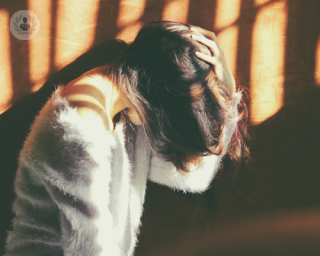Alopecia
Dr Kapil Bhargava - Dermatology
Created on: 11-13-2012
Updated on: 08-23-2023
Edited by: Conor Lynch
What is alopecia?
Alopecia is the medical term for hair loss. It is an umbrella term which includes many different types of hair loss, which each have their own causes and treatments. Types of alopecia include male and female pattern baldness, scarring alopecia, alopecia areata, anagen effluvium, telogen effluvium, alopecia totalis, alopecia universalis, alopecia barbae, androgenetic alopecia, and traction alopecia.
Male pattern baldness is the most common form of alopecia. It affects around half of all men by the age of fifty, though many will have experienced hair loss to some extent by their early thirties.

What causes alopecia?
It generally starts with the hairline receding, followed by the thinning of the hair on the crown and temples. Alopecia is often hereditary. Female pattern baldness can also occur, though it is not as common and, in general, hair only thins on top of the head.
There are numerous other causes of hair loss. These include the following:
- problems with the immune system (such as hyperthyroidism and diabetes)
- skin conditions which can destroy hair follicles (such as lupus)
- chemotherapy and radiotherapy
- hormonal changes
- emotional stress and intense physical stress (such as childbirth)
- changes in diet and long-term illnesses (such as cancer)
The position and the extent of hair loss also varies greatly and will depend on the type of alopecia and its cause. It may affect only the scalp, or the entire body. Hair may grow back after a short period of time, or it may never.
How is hair loss treated?
Hair loss doesn’t necessarily need treating as it does not pose a health risk. However, it can cause distress and it can be difficult to come to terms with as it is considered to be an important part of overall identity. People may be unhappy with their physical appearance which can sometimes lead to depression. There are a number of tests which are used to diagnose alopecia including a scalp biopsy, the pluck test, the pull test, and trichoscopy. In some cases, those affected may choose to wear a wig as a day-to-day solution. Other solutions will depend on the type of alopecia the patient has.
Minoxidil or finasteride can be used to treat male pattern baldness, whereas alopecia aleata is usually treated using steroids, and there are surgical options such as hair transplants and hair implants. Therapy and support may also be key in providing those affected with long-term coping strategies. Some people embrace their baldness by shaving off their remaining hair.
Which specialist treats alopecia?
Generally, the specialist who treats alopecia is a dermatologist. However, if surgery is the decided course of treatment, a specialist hair transplant surgeon or plastic surgeon would be consulted.
Is there any way I can test for hair loss at home?
An effective way to find out that you may be suffering from hair loss is taking roughly 50 strands of dry hair in between your fingers and pulling. You can count how many strands of hair have fallen out. It is said that anywhere between five and ten strands is quite normal and nothing to worry about. However, you may be experiencing hair loss if you notice that you have lost more than 15 strands of hair in between your fingers after pulling gently.
What lifestyle factors may be causing my hair loss?
There are certain factors that can influence or increase one's chances of suffering from hair loss. The main things that people should avoid doing in order to prevent hair loss include the following:
- over-styling your hair
- putting harsh chemical products in your hair
- smoking
- eating an unbalanced diet
Is there a difference between male and female hair loss?
Hair loss does indeed differ for men and women. In women, hair loss is mainly experienced on the top of the head, whereas men tend to notice that they are losing their hair on their hairline and on the sides of their head. Men also suffer more from a receding hairline as well as a balding scalp, whereas women don't tend to experience these distressing developments.
Is baldness curable?
Baldness that is caused by genetic factors is not curable unfortunately. However, the good news is that, if not genetically influenced, the majority of hair loss is reversible.
When should I see a doctor about hair loss?
Patients are highly encouraged to see either a dermatologist or hair loss specialist as soon as they begin noticing sudden and/or unexplained hair loss.

How is hair loss diagnosed?
Hair loss can be diagnosed in a number of different ways. Firstly, doctors may visually examine the patient's hair and scalp. They can also decide that it would be best to thoroughly examine a couple of hair samples of the patient under a microscope. This is typically done in order to diagnose or rule out conditions such as PCOS as well as tinea capitis. In some cases, a blood test may be required to find out if the patient may be suffering from either thyroid disease or iron deficiency anaemia.
How long does hair "live" on our heads for?
Scalp hair lives for roughly three years, and eventually enters into a resting phase on the head.
How much of our scalp hair is in its resting phase?
Interestingly, about 10 per cent of our scalp hair is in its resting phase on our heads.
How much hair is it normal to lose on a daily basis?
On average, we lose around 100 hairs per day.
Does constant shampooing cause hair loss?
No. Shampooing neither causes nor accelerates hair loss. It rather simply helps remove dead hair that was ready to fall out.
Can stress and anxiety lead to hair loss?
Yes, stress and anxiety can certainly lead to hair loss. In fact, any shock to our system can result in between 40 and 50 per cent of our hair cycling into the resting phase, and, a few months later, falling out and all shedding at once.
Can lice cause or lead to hair loss?
No. Head lice do not damage one's hair, nor do they cause hair thinning or lead to hair loss.















